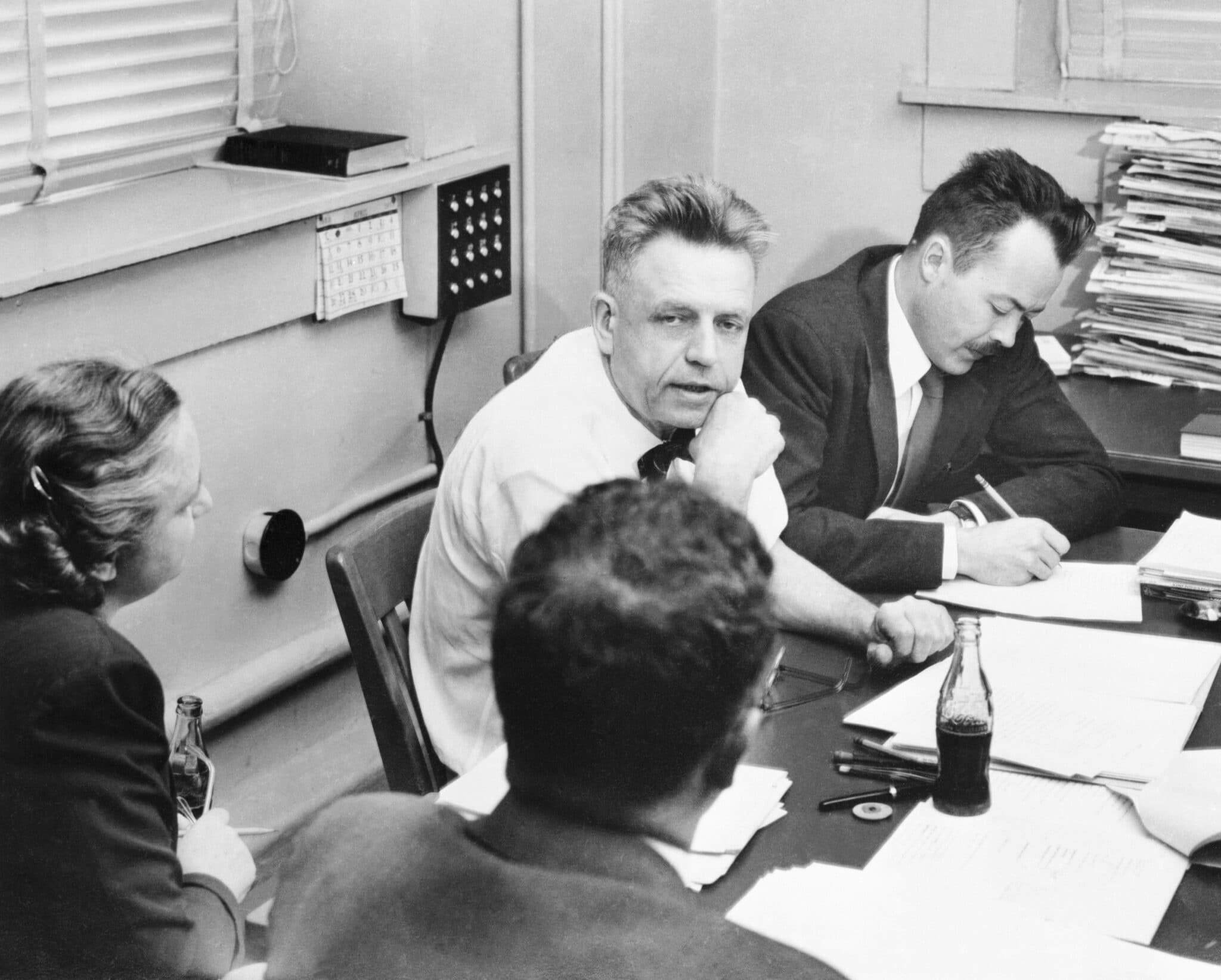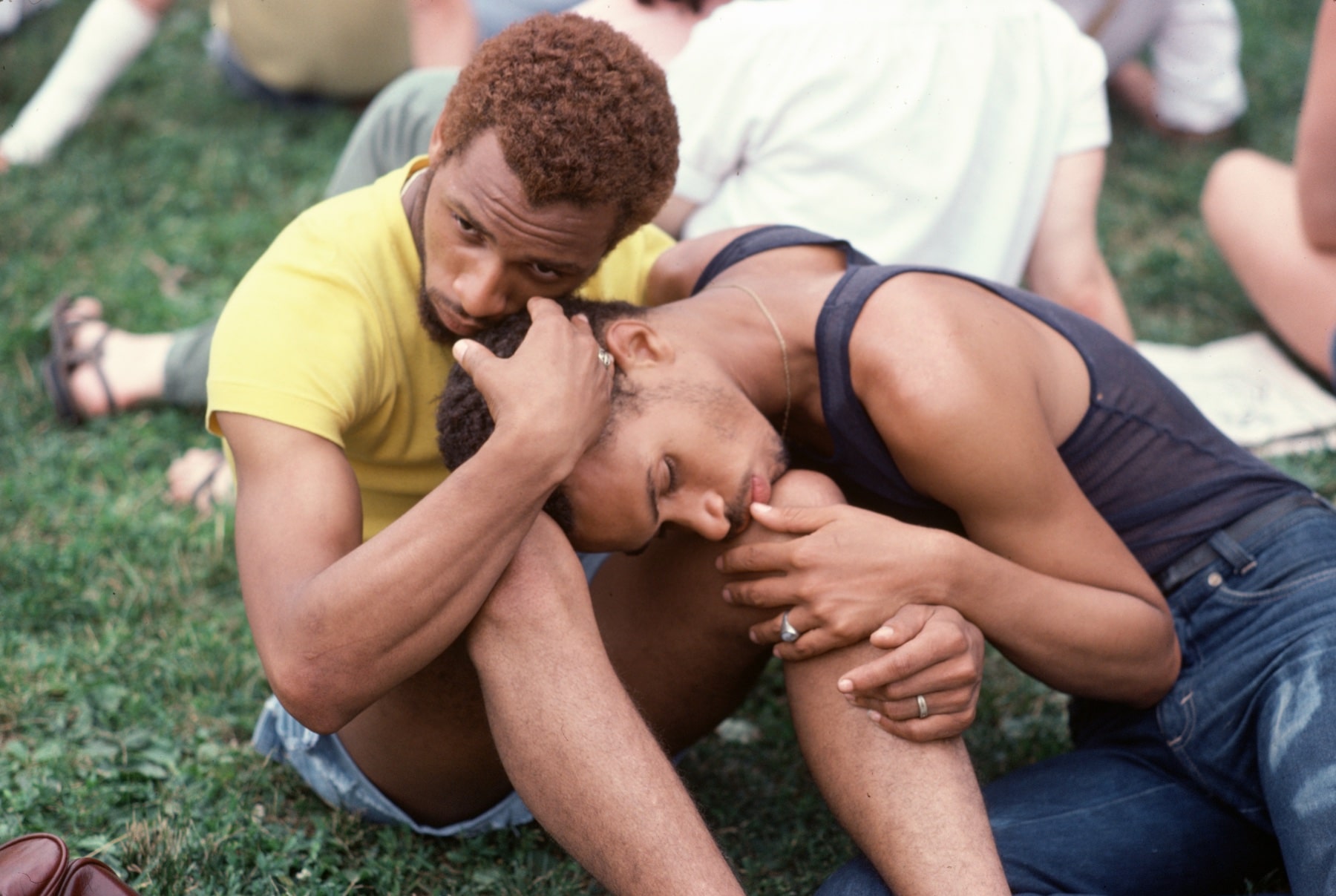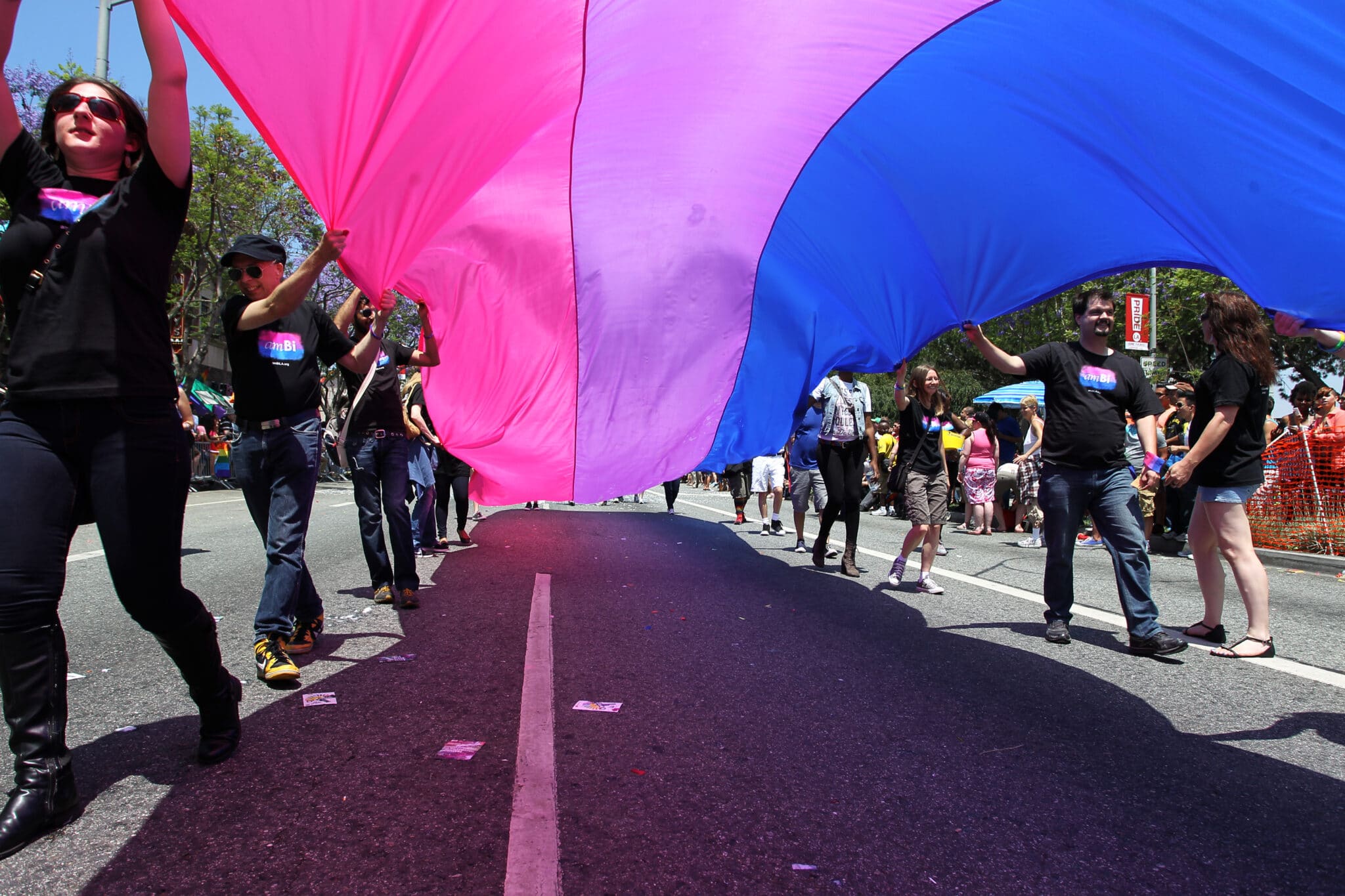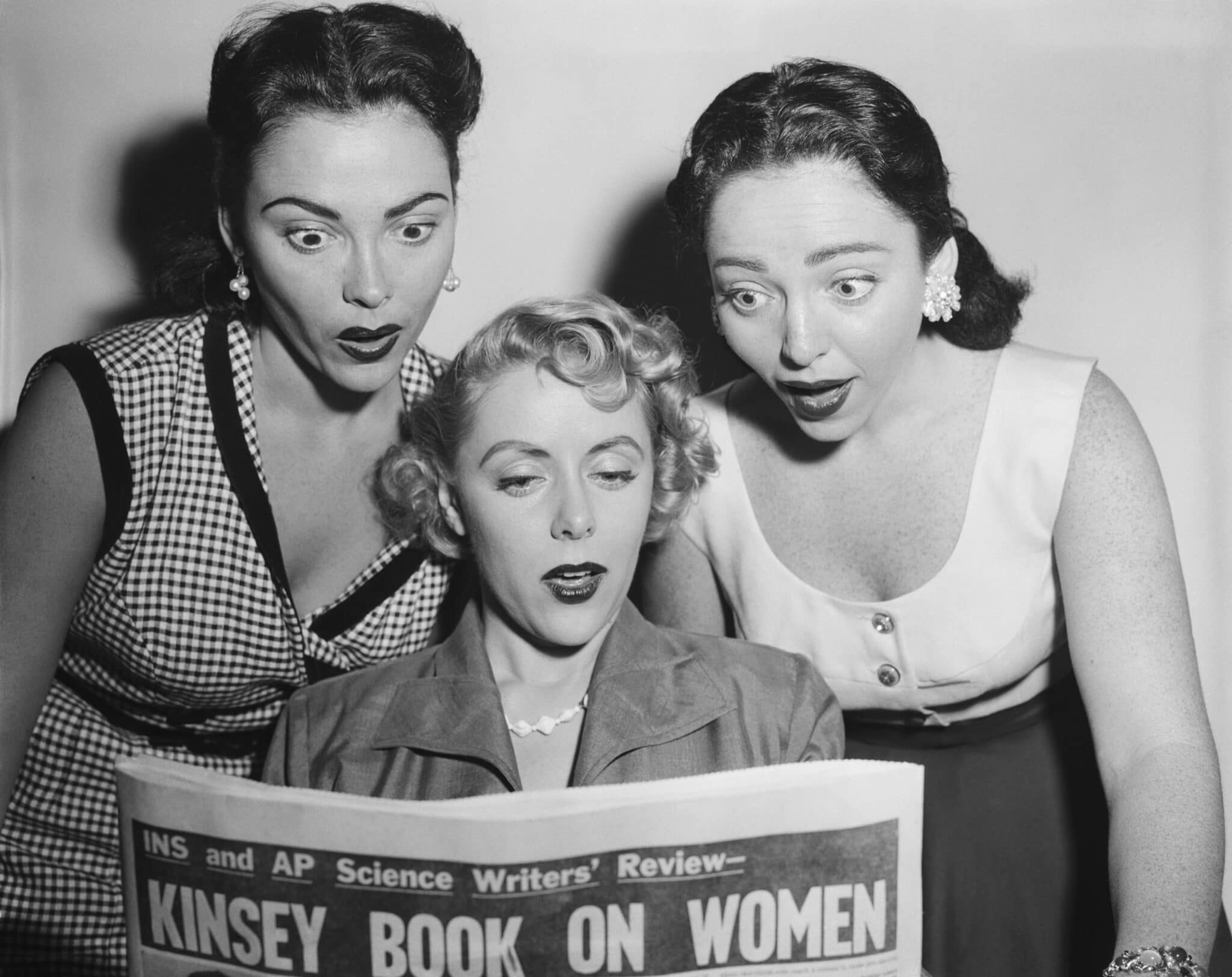Two Barry sisters read review of the Alfred Kinsey Report on Women over the shoulder of Beverly Lawrence (Getty)
If you’re like most people, you’ve probably heard the phrase “sexuality is a spectrum”. In a way, we have Dr Alfred Kinsey to thank for that.
In 1948, American biologist Dr Kinsey and associates Wardell Pomeroy and Clyde Martin developed the Kinsey Scale. Also known as the Heterosexual-Homosexual Rating Scale, the seven-point scale was created to represent the team’s findings from years of research – that human sexuality was not as black and white as it was originally thought to be.
Kinsey’s highly controversial work ushered in a new era of studies on sexuality, thus earning him the title of “father of sexology”. But over 70 years later, does Kinsey’s work still hold up? Is the Kinsey scale still a reliable representation of the spectrum of sexual orientation? Or has it become a relic of the past?
Who was Dr Kinsey?
Dr Alfred Charles Kinsey was an American biologist and professor at Indiana University. Prior to his work on human sexual behaviour, Kinsey spent 20 years as an entomologist, collecting and identifying dozens of species of gall wasps.
It wasn’t until the early 1930s that Kinsey became interested in the study of sexuality. At this point, he began teaching sexual education classes to graduate, senior, and married students, where he would also hand out questionnaires for his research on sexual histories.
By 1947, Kinsey established the Institute for Sex Research (now known as the Kinsey Institute). Armed with financial support from the Rockefeller Foundation, Kinsey and his team pored over hundreds and thousands of sex histories to study sexual relationships and sexual behaviour in the human world.

What is the Kinsey Scale?
The Kinsey Scale is a visual representation of the research findings that Kinsey and company published in Sexual Behaviour in the Human Male (1948). Together with Sexual Behavior of the Human Female (1953), the two books became collectively known as the Kinsey Reports. Considered some of the most influential scientific books of the century, the Kinsey Reports sold almost 1 million copies and were translated to 13 languages.
According to Discover Magazine, Kinsey’s research found that 37 per cent of men had been in a same-sex experience by the age of 45, while 13 per cent of women had had a same-sex encounter. As explained by the Kinsey Institute, the reports showed that “sexual behaviour, thoughts, and feelings towards the same or opposite sex were not always consistent across time”.
As such, the Kinsey Scale broke free from what was the traditional categorisation of sexual orientation at the time – heterosexual, bisexual, and homosexual – and instead presented the following broader seven-point rating system:
0 – Exclusively heterosexual
1 – Predominantly heterosexual, only incidentally homosexual
2 – Predominantly heterosexual, but more than incidentally homosexual
3 – Equally heterosexual and homosexual
4 – Predominantly homosexual, but more than incidentally heterosexual
5 – Predominantly homosexual, only incidentally heterosexual
6 – Exclusively homosexual
X – No socio-sexual contacts or reactions
“The world is not to be divided into sheep and goats”, wrote Kinsey in the report. “Not all things are black nor all things white…only the human mind invents categories to force facts into separate pigeonholes. The living world is a continuum in each and every one of its aspects. The sooner we learn this concerning sexual behaviour the sooner we shall reach a sound understanding of the realities of sex”.
In short, Kinsey believed that sexual orientation was not as rigid as most people believed at the time. Instead, he saw that many people exhibited all types of sexual behaviour, even if it contradicted the labels with which they identified. As such, Kinsey sought to normalise the idea that sexual orientation is more akin to a spectrum than a strict binary.
Understandably, upon its release, Kinsey’s research was met with a lot of controversy. For many, Kinsey’s insistence that humans could be more than either gay or straight was an affront to everything they knew about themselves. It also meant that once you exhibited some type of homosexual behaviour – even if you didn’t identify as a homosexual or experienced same-sex attraction – then you could find yourself in some very hot water.
You have to remember that, at the time, homosexuality was considered illegal in most parts of the world, including the US and the UK. In fact, the main reference book in psychiatry, the Diagnostic and Statistical Manual (DSM), didn’t remove homosexuality from its list of diagnoses until the early 70s.

Is the Kinsey Scale test accurate?
So there is no such thing as a Kinsey Scale “test” or a Kinsey Scale “quiz”, per se. While it was once used to measure the balance of heterosexuality and homosexuality in a person relative to their history of sexual attraction and experience, it isn’t really used as a diagnostic tool anymore. Instead, think of it more as a representation of the sexual fluidity of human beings!
But if you really wanted to, technically speaking, you can study the scale and decide on your position on it.
Is the Kinsey Scale still relevant today?
The short answer: yes and no.
Kinsey and his associates moved the needle in terms of how a person’s sexual orientation is studied and understood. However, that doesn’t make their work infallible, especially when compared to what we know today.
Here’s how the scale misses the mark:
The scale fails to represent asexuals
On the Kinsey Scale, asexuals are lumped under the “X” rating, which is defined as people who have had “no socio-sexual contacts or reactions”. However, for many asexuals, this is simply not an accurate representation.
Asexuality is defined as the lack of sexual attraction to others. For many, asexuality is a sexual identity in the same way as being gay, lesbian, or bisexual are. It’s also considered an umbrella under which various forms of asexuality exist, from demisexuality (people who only feel sexually attracted to those they form emotional bonds with) to akoisexual (people who experience attraction but do not wish to have those feelings reciprocated).
The scale conflates sexual attraction and sexual activity, while leaving out sexual identity
Kinsey’s research focused mostly on the sexual behaviours that his interviewees acted upon. What he and his associates failed to consider was that sexual behaviour is not the same as sexual attraction. On top of this, one’s sexual feelings and behaviours do not necessarily reflect how one would identify.
The scale implies that attraction to one sex cancels out attraction to another
This is something that a lot of bisexual people have gripes with. The Kinsey Scale implies that the more attraction you have towards one gender, the less you have towards another. While behaviour can be measured (as in, you can count the number of sexual experiences a person has had), attraction is much harder to quantify.
This implication is especially frustrating for bisexual people who often feel invalidated by both gay and straight people. Many bisexuals feel that if their attraction is not a 50-50 split between the same and the opposite sex, that their bisexuality is somewhat invalid.
But take for example a bisexual woman who is attracted to both men and women but has only dated men exclusively. If you follow the scale, that woman is a “0 – exclusively heterosexual”, despite the fact that she feels sexual attraction to other women.

Is there another sexuality scale aside from the Kinsey Scale test?
If you’re looking for a more nuanced model for identifying your sexual orientation, consider the Klein Sexual Orientation Grid and the Storms Scale. There are other scales out there – around 200 or so, in fact – but these two are by far the most popular.
The Klein Sexual Orientation Grid was first introduced in 1978 by psychiatrist and sex researcher Dr Fritz Klein. Appearing in his book The Bisexual Option, the Klein Grid was created as a learning tool to give people a more holistic understanding of the complexity of human sexuality. The Grid is made up of seven variables and three situations – past, present, and ideal.
The Storms Scale, on the other hand, was developed by psychologist Michael Storms in the early 80s. The scale focuses more on eroticism rather than sexual behaviour.
Does the Kinsey Scale still matter?
The Kinsey Scale was once a groundbreaking model of human sexuality at a time when the very idea of sexual orientation as anything but a binary was considered taboo. As such, it’s relevant in that it’s a seminal work in the field of sexology.
It’s also important to note that, for some people, having some kind of label or system of identification helps those who are questioning to better understand who they are and to find their “tribe”. In this way, the scale can still be a useful tool for those who are still exploring their sexuality.
